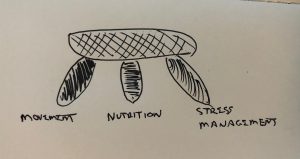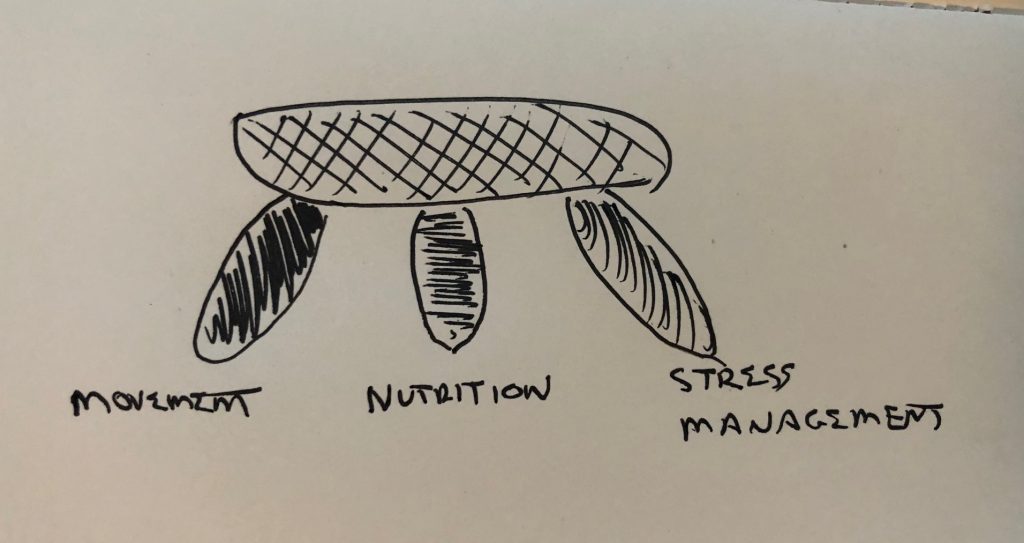If you’re on the path of fat loss, strength gains, or performance improvements, you have to remember: to be an optimally healthy human, you’ve got to act like an optimally healthy human. It’s not enough to just lose weight, or lift heavy, or crush at your sport of choice. You must consider how your goals impact your life, and how your life impacts your work towards your goals.
With the goal of improving your health, your life, and your performance, consider a three-legged stool:

The three legs are movement, nutrition, and stress management. To make this stuff work, you’ve got to consider all three.
We started with the first leg, movement, and now we’re moving onto the second leg, nutrition.
How do you relate to nutrition? Which of these statements resonate with you? And yes, you can choose more than one.
- Nutrition is easy. I know what to eat.
- Nutrition should be easy. Food is food. Don’t eat too much. But I feel stuck.
- Nutrition makes me hide under the bed. I don’t want to talk about it or think about it. Just give me my ice cream and leave me be.
- I can eat anything I want. I have a fast metabolism/train all the time/a body I’m happy with.
- If I have to change how and what I eat to reach my goals, I guess it’s time to reconsider my goals.
- I eat healthy and clean, high-quality food.
- I’ve tried everything. Keto, fasting, veganism, all-the-meats-ism.
At the end of the day, how is that working for you? Are you seeing the results you want? Making measurable progress towards your goals?
I have a secret to tell you…come close…be warned that it might sound like bad news…if you’re not seeing measurable or describable progress towards your goals, your nutrition isn’t working for you.
This is where the stool analogy comes in; if you’re training hard 3-5 days a week, on a smart program, and you’re not making progress, you’ve got to look at another leg, NOT a new training program. The body will adapt to stimulus, as long as its underlying needs are met.
Yep, that means that you’ve got to eat smart to get where you want to go.
Nutrition comes down to a few simple concepts. And while this is simple, that doesn’t mean it’s easy. Ask anyone who’s worked to lose fat or gain massive strength: the work takes effort, diligence, planning, and patience. The ideas are simple; execution is hard.
- Get enough protein. Start with lean, high-quality protein sources, and supplement as necessary. Your bodyweight in pounds, as grams of protein per day, is a good place to start. If you’ve got liver or kidney dysfunction you need to check with your physician.
- Eat a variety of colorful vegetables and fruits each day. If you’ve got weight to lose, aim for a 90/10 ratio of vegetables to fruit; if you’re lean, or building strength, a ratio of 75/25 is good.
- Calories count, but we don’t count calories. Yes, if you overeat (take in more energy than you need), you’ll gain weight; if you’re training for strength, that’s a good thing. If you’re training for fat loss, that’s a bad thing. But rather than counting calories, be consitent in your food intake week-to-week, especially in energy-dense foods (anything processed or packaged, non-lean meats (bacon, sausage, etc.), and fruit (yep, we need to consider the energy density of fruit – hence the vegetable-heavy ratios above). If you’re seeing progress in the direction you want, carry on. If not, explore more/less total energy intake. Adding or subtracting one apple a day could be enough to stimulate progress.
- Eat some high-quality fat with most meals. A couple of tablespoons of oil on a salad or when cooking, or a small handful of almonds, will serve you well.
Every student I’ve worked with who’s seen meaningful, lasting progress – whether losing 10% of bodyweight in two months, vastly improving physique while gaining 4 pounds, or performing better on the soccer field, has followed these simply ideas. And they’ll all tell you that they had to change their relationships with food, and while not easy, with support, it was doable.

